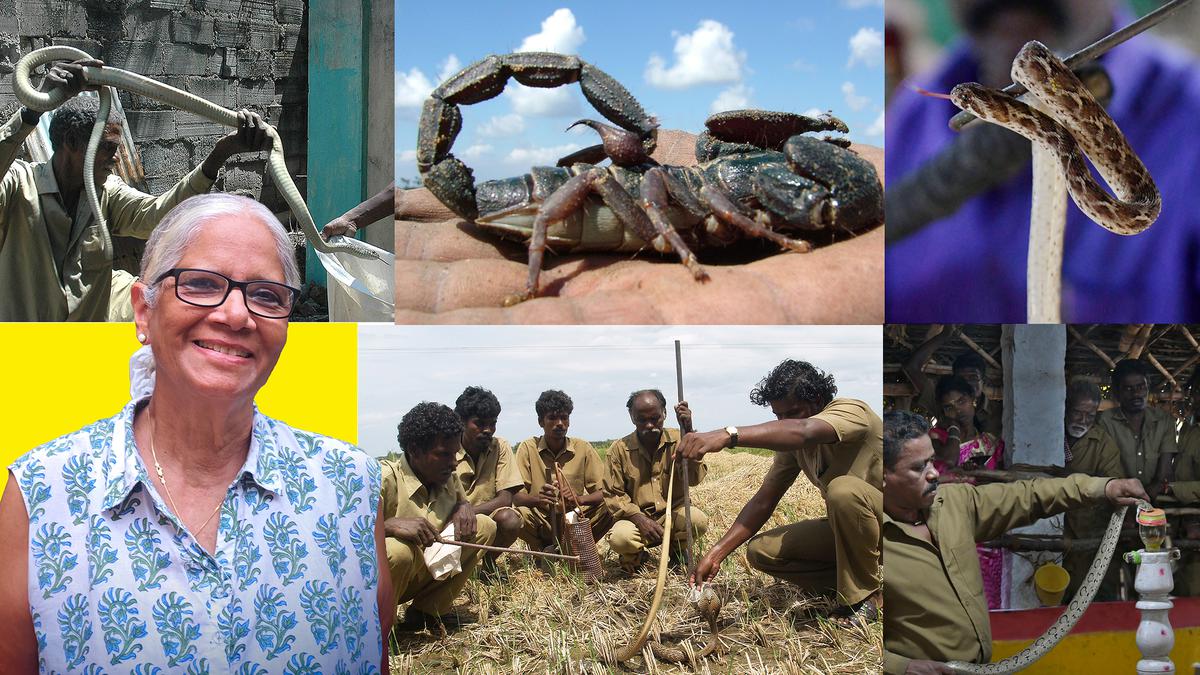
Walking with scorpions, talking to termites: Zai Whitaker on her new novel based on Irulas
The Hindu
In Termite Fry, the author and co-founder of The Madras Crocodile Bank Trust and Centre for Herpetology, Zai Whitaker, traces the changing livelihoods of the Irula tribal community through the story of her protagonist, young Thenee, and her family
They catch cobras, live in huts deluged by scorpions, roast termites they expertly harvest from mounds as tall as them, are called upon to exorcise ghosts, talk to birds, and have an intimate knowledge of medicinal plants. Meet Thenee and three generations of her family, members of the Irula tribal community in Tamil Nadu’s Eastern Ghats. Author and The Madras Crocodile Bank Trust and Centre for Herpetology co-founder Zai Whitaker’s new book, Termite Fry, a work of ‘fiction based on truth’ is set at the cusp of the passage of the Wildlife (Protection) Act, 1972, which banned hunting wildlife, irreversibly changing the lives of the family and community. But a ray of hope presents itself, allaying their fear of losing their primary means of income — hunting snakes for their skin — forever.
Edited excerpts from an interview with Whitaker, best known for her children’s books, including Salim Mamoo and Me and Adventures of the Humongoose Family.
I remember anecdotes of Irula suppliers of snakes, rats and frogs. They were asked to get down from buses because of their live cargo. There was a lot more social discrimination in the 70s, and we saw incidents in hotels, hospitals, trains and buses where the Irulas were humiliated. The stories about wriggling bags in buses were often related with laughter; humour helped them get through challenging times.
Today, they catch snakes for laboratories that produce antivenom, and they use the Irula Snake Catchers’ Industrial Co-operative Society’s own air-conditioned van to travel. Many have motorbikes, and send WhatsApp pictures of an unusually large snake they might have seen… but these are the few lucky ones who are licensed members of the Society.
Political decisions are important markers in the lives of Adivasis all over the world. And I felt that the sudden ban on the snake skin trade was a good metaphor for this; so I decided to build the Termite Fry story around this event. It was definitely a good move in terms of snake conservation, but the ban removed the central Irula livelihood without offering any alternative employment. Their traditional hunting grounds were being taken over for industrial and residential development; food-sources such as monitor lizards, were protected under the Act. This would have been a wonderful opportunity for the government to incorporate these forest-technicians into departments such as forests, fisheries and tourism.
The most useful resource was my own memory, because I was lucky enough to be plonked into the world of the Irulas when many of them were still living the ‘old culture’. My ex-husband Rom [herpetologist Romulus Whitaker], who some of them called the ‘white Irula’, was often in the field with them and I tagged along on rat, termite, snake, crocodile hunts. I shared the odd mongoose or monitor lizard curry with them. There were special friends, such as little Kali (now a father of two) who was our sons’ playmate and took him scorpion hunting in his village. Kali once brought back one as a ‘gift’ for me.
The credit goes to Rom. By the time the Wildlife (Protection) Act came into effect, he knew several older snake-catchers.. One of them was Natesan, or Sureman as he was known. Natesan, Rajamani, Chockalingam —now all departed — had many discussions with him about the venom centre idea, seated under the mango trees at our home. Today, the co-operative has some 350 members with licences to catch the ‘big four’venomous snakes. At present, we (The Crocodile Bank) are helping them plan a state-of-the-art serpentarium to upgrade their venom quality and snake husbandry practices.













